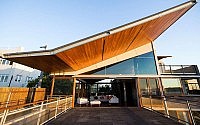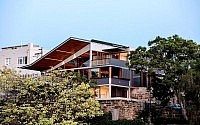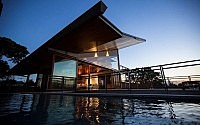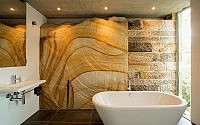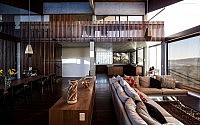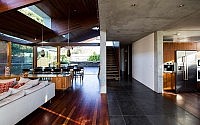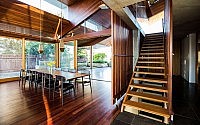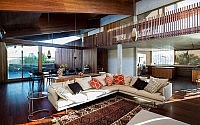Edge House by Peter Stutchbury
Designed in 2013 by Peter Stutchbury, this contemporary seaside residence is situated in Birchgrove, Australia.

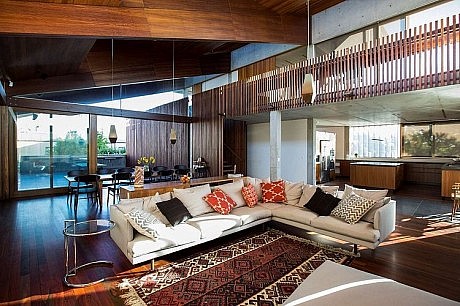

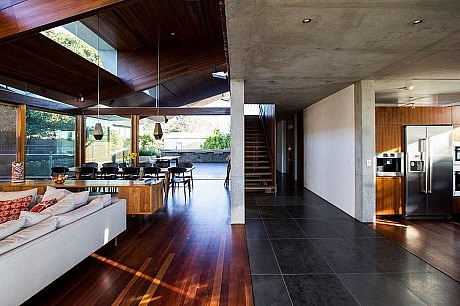

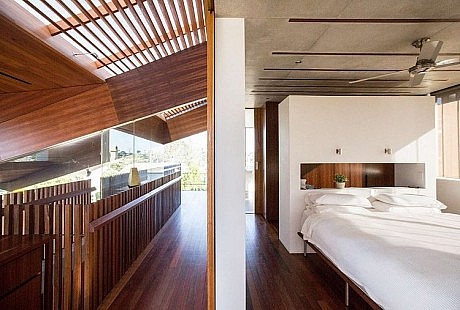
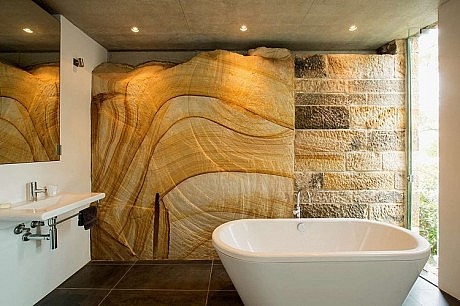
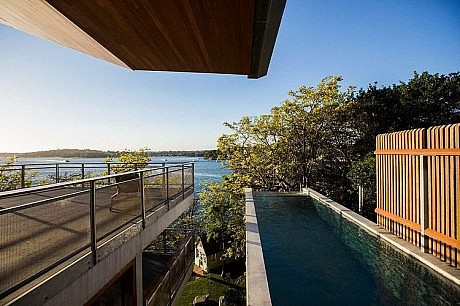

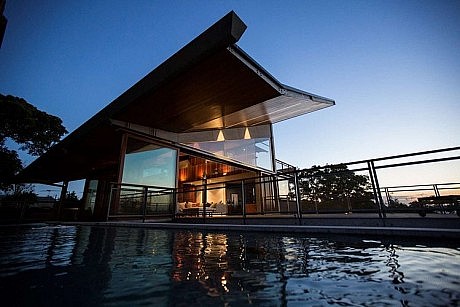
Description
The Edge House is about pushing design and structure to the edge of its limits. These innovations create a very livable home tailored to suit extended family gatherings.
Despite the difficult site, we packed a few “firsts” into this project. Below is a selection of notable challenges, innovations, and features.
Access: The entire project including 42,3766 cubic feet of excavated rock, the massive structural steel and truss members, and around a dozen concrete pours were all restricted by access up the long, narrow, and crowded Louisa Road.
Neighbor Relations: With so many people cheek by jowl, it took a lot of work to keep the peace with such disturbance going on. We did a lot of goodwill car and window washing, did letter drops updating neighbors of upcoming activity, and generally did our best to ensure our clients would move in with good neighborly relations.
Site Stability: A 16-foot-high heritage sandstone retaining wall on the boundary had to be stabilized with steel whalers and anchors before excavation could begin. Then unstable rock outcrops were identified so we worked with the engineers to provide permanent support.
Masonry: Only when the bedrock was exposed was the decision made to feature the sandstone as an internal wall by deleting the masonry internal skin. Steele advised the client that it wasn’t possible to waterproof bedrock, but we did what we could to make it workable. We cut a channel in the top of the rock with drainage lines to divert any surface water, and installed an extra floor waste and fall in the tiled floor to collect any moisture. So far, it has stayed remarkably dry.
Greenstar Concrete: Steele Associates took the initiative to use only the maximum 60 percent recycled content concrete on this job in support of our sustainability aims. We had to convince the engineer that it would be up to the long cantilevers, off-form exposed pool, and off-form finishes. Boral were very helpful in providing detailed information on anticipated performance.
Off-Form Concrete: The concrete construction was incredibly demanding. The architect called up alignment of formwork sheet joints in a 3D grid, making the whole set-out like a Rubik’s cube. Lights, shower heads, door pivots, and strikers all had to be installed in the formwork because the concrete is the finish and there was no opportunity to run cables, conduits or ducts anywhere else.
Steel Cantilevers: The 20-foot-high cantilevered roof wings were engineered to be as thin as possible. When we installed the steel frame it vibrated in the wind, and became known as “The Hummingbird.” It took three additional applications of increasingly beefy steel straps to quiet it down.
Concrete Cantilevers: jutting out 15 feet beyond the last column, the concrete decks were post-tensioned with stainless steel threaded rods set into the slabs. They were further stiffened with steel strapping over the slabs. Finally, the tile screed was bonded to the slab and reinforced with steel mesh to provide additional stiffening to these oversized “diving boards.”
Trusses: The trusses over the main living area span 30 feet and were factory built and craned into place with their structural ply linings. Once installed, Steele’s carpenters finished them with timber veneer paneling in-situ from scaffold towers.
Linings: There’s not a single sheet of plasterboard in the house. As well as off-form concrete and rendered finishes, an abundance of Australian hardwood T&G boards, veneers, recycled beams, and battens are all finely detailed and fastidiously installed by Steele’s carpentry team.
Applied Finishes: All wet area walls are finished with acrylic render instead of tiles. Steele was diligent in determining a system of compatible waterproofing, render, and sealing products to provide a durable outcome in this unusual finish. Rendering into shampoo recesses, including slight falls took particular skill and care.
Doors and windows: The pared-back window design meant we had to set aluminum glazing channels into the concrete columns and slab soffits and install massive sheets of toughened glass to create the windows. Large hardwood sliding doors run frameless on minimal tracks installed by Steele’s carpentry wizards.
Tiling: The large area of stone tiling to the entry and BBQ terrace needed drainage, but the lack of setdowns and requirements for flush finishes severely restricted opportunities for falls. Our solution was to install a 0.5-inch copper pipe drain to the entry terrace as a way of relieving ponding without creating ridges between tiles.
Finish Carpentry: The specification called up hardwood battens set into the concrete ceilings in a ‘Fibonacchi Series’ configuration, referring to the exponentially increasing numerical pattern. The set-out was one thing, but a neat finish was another. We built sacrificial pine battens into the formwork, cutting them into trapezoids to ensure easy removal. We then replaced them with trapezoidal hardwood battens during the fit-out.
Joinery: The ensuite has a full-height mirrored cupboard door. The joiner installed on 5 hinges, but the weight of the mirror was too great. We had to install a custom aluminum support system over the hinges to prevent them dropping over time.
Screens: The western facade required privacy screens. The architect wanted frameless strips of CFC with minimal support. We worked closely with him to devise a customized system that would be strong enough to withstand high winds, while giving the light, clean look he was after.
Electrical and Plumbing: There was really nowhere to hide conduits or pipes. Everything had to be run through the concrete in formwork stage prior to pour. We concealed services running across the clear roof section in copper pipe sleeves which fit the aesthetics of the house.
Lighting: Downlights had to be set into the formwork prior to pour. To prevent them shifting, we worked with the manufacturer to design a custom “can” fitting with a bolt welded into the top of the fitting. This was connected to a threaded rod and plywood disc that fixed the fitting to the formwork during the pour. The light fitting and cabling was then installed during the fit-out.
Ventilation: At the ridge of the main roof we installed automatic operable louvres to exhaust hot air, creating stack effect cooling for the house whereby cool air is drawn in at the lower levels to replace the hot air that rises and escapes from the louvres.
Heating and Cooling: The house, swimming pool, and domestic hot water are all heated by a solar hydronic heating system. An array of evacuated glass tubes of the roof collects solar energy and connects to heat exchange tanks which pass heated water through the concrete structure via pipes set into the slabs.
Swimming Pool: The swimming pool is an off-form concrete, cantilevered pool featuring glazed panels. It had to be poured in a single pour to avoid a cold joint around the base. There was a huge amount of reo in the structure to stiffen it against the water load. This made it very difficult to vibrate the concrete to the Class 2 finish required.
- by Matt Watts